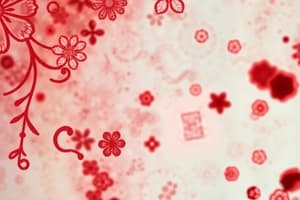Podcast
Questions and Answers
Which of the following is a component of an amino acid?
Which of the following is a component of an amino acid?
- Carbon, Hydrogen, Oxygen, Nitrogen
- Lipid, Carbohydrate, Protein, Nucleic acid
- Nucleotide, Phosphate, Ribose, Adenine
- Amino group, Carboxyl group, Hydrogen atom, R group (correct)
What color is produced when proteins and peptides react in the Biuret test?
What color is produced when proteins and peptides react in the Biuret test?
- Green
- Yellow
- Purple (correct)
- Blue
The Biuret test primarily detects the presence of what in a sample?
The Biuret test primarily detects the presence of what in a sample?
- Proteins or peptides (correct)
- Nucleic acids
- Carbohydrates
- Lipids
Which reagent is used in the Biuret test?
Which reagent is used in the Biuret test?
What is the principle behind the Biuret test?
What is the principle behind the Biuret test?
Which among the following tests gives positive results with all proteins and amino acids?
Which among the following tests gives positive results with all proteins and amino acids?
Which component in an amino acid is unique for each different amino acid?
Which component in an amino acid is unique for each different amino acid?
Which test can be used to detect proteins in a biological mixture?
Which test can be used to detect proteins in a biological mixture?
Why does the Biuret test produce a purple color?
Why does the Biuret test produce a purple color?
What is the purpose of adding NaOH in the Biuret test?
What is the purpose of adding NaOH in the Biuret test?
Which of the following reagents is used in the Biuret test?
Which of the following reagents is used in the Biuret test?
What does the intensity of the purple color in a Biuret test indicate?
What does the intensity of the purple color in a Biuret test indicate?
Flashcards are hidden until you start studying
Study Notes
Amino Acids and Proteins
- An amino acid consists of an amino group, a carboxyl group, a hydrogen atom, and a distinctive R group bonded to a carbon atom.
Protein Detection Tests
- Color producing tests are used to detect proteins in biological mixtures.
- These tests include the Biuret, Ninhydrin, Millon's, and Hopkins - Cole tests, among others.
Biuret Test
- The Biuret test is a general test that gives a positive result with all proteins and amino acids.
- The test depends on the reaction of cupric ions (Cu+2) in an alkaline solution with peptide linkages of the protein to produce a purple color.
- Objective: detect the presence of peptides or proteins in a sample.
- Principle: Proteins and peptides form a purple color when treated with an alkaline solution of dilute copper sulfate.
- A positive test is indicated by the formation of a purple color.
- The color density is proportional to the amount of proteins present.
- Biuret reagent: alkaline copper sulfate solution.
Biuret Test Procedure
- Add 1 ml of 2% albumin (protein) to a tube.
- Add 0.5 ml of biuret reagent and mix well.
- Add 2 ml of 10% NaOH to the tube.
Amino Acids and Proteins
- An amino acid consists of an amino group, a carboxyl group, a hydrogen atom, and a distinctive R group bonded to a carbon atom.
Protein Detection Tests
- Color producing tests are used to detect proteins in biological mixtures.
- These tests include the Biuret, Ninhydrin, Millon's, and Hopkins - Cole tests, among others.
Biuret Test
- The Biuret test is a general test that gives a positive result with all proteins and amino acids.
- The test depends on the reaction of cupric ions (Cu+2) in an alkaline solution with peptide linkages of the protein to produce a purple color.
- Objective: detect the presence of peptides or proteins in a sample.
- Principle: Proteins and peptides form a purple color when treated with an alkaline solution of dilute copper sulfate.
- A positive test is indicated by the formation of a purple color.
- The color density is proportional to the amount of proteins present.
- Biuret reagent: alkaline copper sulfate solution.
Biuret Test Procedure
- Add 1 ml of 2% albumin (protein) to a tube.
- Add 0.5 ml of biuret reagent and mix well.
- Add 2 ml of 10% NaOH to the tube.
Studying That Suits You
Use AI to generate personalized quizzes and flashcards to suit your learning preferences.




